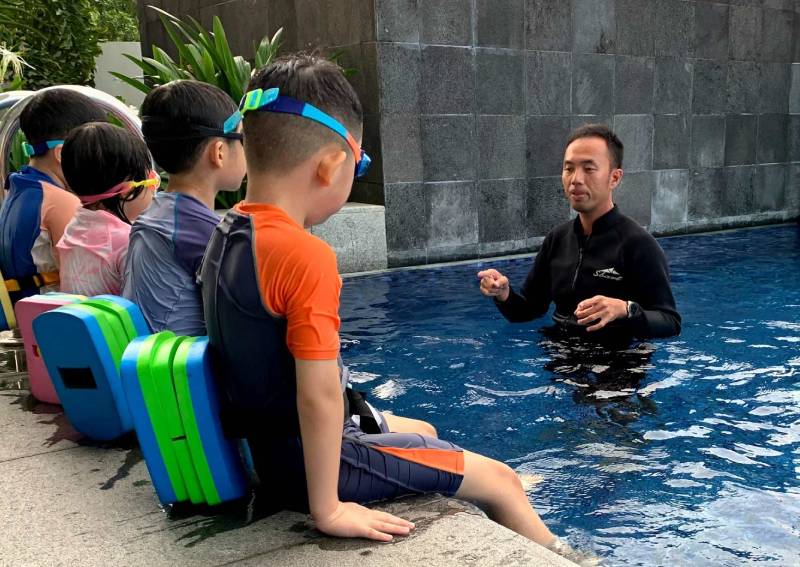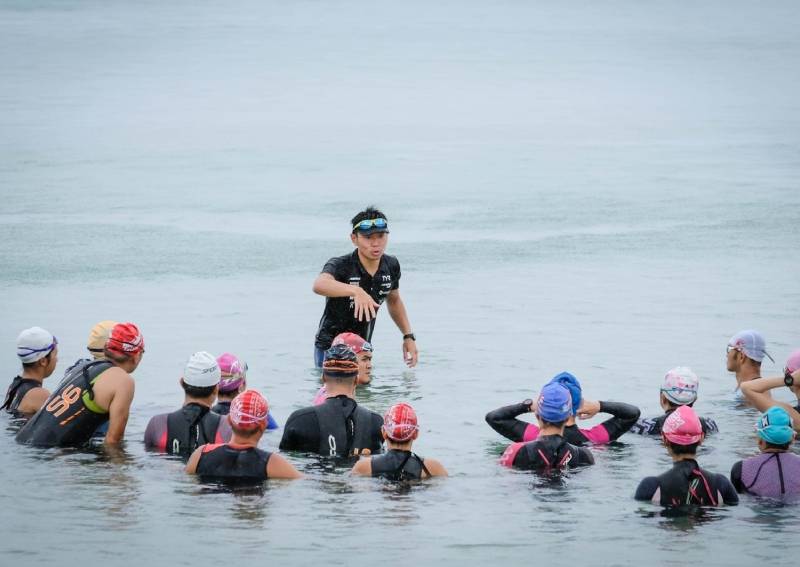Inspired by NS stint in the navy, they aim to impart crucial swimming skills to all


It's never too late to pick up a new skill, especially a life-saving one that might just rescue you or someone else one day.
In this case, we're referring to swimming — and no hor, we don't mean simply swimming laps in the calm waters of your nearest pool, we're also referring to the ability to navigate any body of water safely — most importantly, open water.
Who better to impart such essential skills than a pair of consummate swimming coaches comprising an ex-NDU serviceman and a competitive swimmer?
The former, 31-year-old Ray Kua (who graduated from Sports Science and Management in NTU), and the latter, Jay Lin, 32, met not in the pool but on the court when they were on the basketball team in Jurong Junior College.
Their friendship has since blossomed into a swim-pressive partnership and culminated in the founding of local private swimming school SwimRay.
We take a deep dive into the pair's passion to impart crucial skills to the community, how their NS experience was a turning point in their lives, and why swimming isn't just about being able to glide gracefully with perfect form.

Ray, you were a Frogman in the Naval Diving Unit (NDU) and served as a combat diver in the Clearance Diving Group during national service. Were you already a pretty good swimmer? How did the NDU experience help you level up?
Ray: Before enlistment, I could only swim breaststroke and was a terrible swimmer. I was unsure of what I was getting myself into, yet extremely motivated to complete the course. NDU was rigorous, and taught us a lot of combat survival skills underwater.
Contrary to popular belief, NDU focuses on combat survival skills, rather than just swimming fast. It places emphasis on mastering skills that will aid us in situations of distress underwater, including rescue in combat or peacetime operations.
I was a sub-par swimmer, and faced a tough time picking up the combat survival skills. Skills such as drownproofing (where we had to tie our hands and legs to swim) were a huge challenge, as was managing underwater situations where we ran out of air supply.
During "Hell Week", we had continuous physical training and numerous stressful conditions underwater, all without sleep for five days and four nights.
[embed]https://www.instagram.com/p/BsSt_84nBMI/?utm_source=ig_web_copy_link[/embed]
That said, upon graduation, I mastered all the essential skills, and gained extremely high underwater confidence. I was then posted to the Clearance Diving Group, where I conducted search and salvage rescue operations in a peacetime capacity, be it for the Navy, or for salvage operations with drowned bodies.
The skills we were taught came in handy because it was pitch-black most of the time and working conditions were extremely stressful.
My experiences inspired me to pass them on to every child and adult who wants to learn to swim. Also, I felt that there was a lack of survival skills taught in Singapore. The common perception is to pass the SwimSafer tests for children, or to learn the strokes for adults.
Yet, the real key is to survive in an accident. And this was [an area] I felt I could bring value to. By incorporating elements of surprise, distress conditions, and tailoring the skills to the appropriate age group, I was confident of value-adding to others.

Jay, how did you go from competitive swimming to finding a passion for coaching?
Jay: I grew up swimming competitively in Taichung, Taiwan. The training was extremely rigorous — we were thrown into open water to learn, train, and race.
I discovered my passion for coaching in NTU. I captained the biathlon team, and was assigned as the head coach after graduation. My time with the team made me realise I could add so much more value to the swimmers in Singapore, be it in competitive swimming, stroke correction or open water swimming.
Thus, the journey to SwimRay began. With me heading the competitive and stroke correction element with open-water swimming as our end goal, and Ray taking charge of the Learn To Swim syllabus drawing from his experience in NDU, SwimRay was born.

You also served NS in the Navy but as a combat medic. What kind of impact did that experience have on you and what you're doing now with SwimRay?
Jay: My time there allowed me to put into good use my swimming experience to help distressed swimmers. I realised many did not have the necessary survival skills or proper stroke techniques.
This came as a surprise to me as I understood that learning swimming is essential in Primary School in Singapore. As such, I felt there was so much more to teach and value-add.
It is important that everyone has access to such skills to survive in any water body and situation. Many in the Navy told me they had never swum in the open sea, and hence, were pretty stressed out during such moments.
This was definitely a skill that needed to be taught, and was also the cornerstone of my beliefs in ensuring every client who comes to us ends off their journey at SwimRay fully equipped to handle any accident in any water body.
[embed]https://www.instagram.com/tv/CbeREtIFVv4/?utm_source=ig_web_copy_link[/embed]
[embed]https://www.instagram.com/p/B3YtW3qFyfm/?utm_source=ig_web_copy_link[/embed]
What misconceptions do most people have about swimming and learning how to swim?
Ray: In my experience, many people associate swimming with learning strokes and moving gracefully. Yet, the foundation of swimming is itself an essential skill. That is the "to swim" in "learn to swim". If one cannot float, survive or navigate in distressful conditions, what good would it be even if they can do a stroke gracefully?
Surviving in an accident, and swimming gracefully and quickly are two completely different things. In SwimRay, I emphasise the importance of "learn to swim" and accident survival skills for swimmers before moving on to stroke mastery and speed efficiency.
Jay: As I was exposed to open water swimming in my childhood, I could understand the fears that came with being unable to swim. Many people associate swimming with swimming in a pool, which is a big misconception, as a pool is a controlled environment.
A true testament to one's swimming skills is when they can survive and swim in open water. It does not have to be in the sea, but imagine situations where you accidentally fall into the river, or any water body. The waves, tides, and objects would catch many people by surprise.
As such, I always advocate that after learning survival skills and stroke mastery, swimmers have to learn open water swimming. This would enable them to master swimming in all environments.
[embed]https://www.instagram.com/tv/CZGWzTFlKv7/?utm_source=ig_web_copy_link[/embed]
You also conduct an awesome Charity Swim Program that gives back to the community. Tell us more about whom you support.
We are currently running a programme with the Singapore Association of the Visually Handicapped. Our coaches conduct regular voluntary coaching with the participants who are visually impaired.
We feel that swimming is a joy and important skill that should be made available to everyone, including handicapped individuals. We want everyone to be able to enjoy swimming.
SwimRay is also in touch with other organisations such as the Down Syndrome Association. We strongly believe in giving back to the community, in the same way the community has supported us.
This initiative also contributes greatly to our coaches' performances. More often than not, it broadens their perspective on empathy, which is the most important attribute in coaching.
If any charity organisations would like to collaborate, we would love for this to be a little shout-out that we're looking forward to potential opportunities for collaboration.

How does SwimRay stand out among the other swimming schools in the industry?
What stands out is our syllabus and the coaches' training. We have our own unique SwimRay Aquatic Roadmap, which brings beginners from the water phobia stage, to mastery of accident survival skills, to open water swimming.
We believe this is the first syllabus of its kind in Singapore, and draws on our experiences in NDU and competitive swimming. Our coaches are extensively trained in these aspects, with each of them specialising in classes and programmes for different ages and needs, and are able to handle students in different phases of learning.
We also believe that our USP lies in the dedicated administrative support we provide. We adhere to a "School to You" approach, where each client is tagged with a team of staff that attends to performance reviews of coaches, scheduling, rostering and other administrative needs.
ALSO READ: Swimming makes you hungrier and likely to eat more at the next meal - new research
This article was first published in Wonderwall.sg.